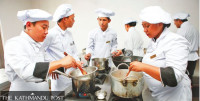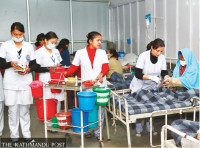Miscellaneous
Briquette economy
Small communities in around 25 districts across Nepal are heavily involved in the production of briquette/pellets.
Small communities in around 25 districts across Nepal are heavily involved in the production of briquette/pellets. They have been assisted by various national and international agencies and companies throughout the years. Currently, there are only four structured manufacturers and about 30 community groups involved. These community groups, involving 2,000-3,000 members, are organised into 25 collection centres to produce char by harvesting shrubs, twigs and branches. About 1,000 members engage for five months every year to produce and sell char. Additionally, there are 150 full-time employees working with the four companies and around 1,000 retailing and wholesale entities.
Briquettes and pellets were traditional fuel sources for rural communities in China and Korea. At the beginning of 80s, Nepali NGOs and the government both started promoting these products as sustainable fuel in the face of forest degradation, energy shortage and to reduce indoor pollution. However, it took over 25 years for the Himalayan briquette to become available commercially in departmental stores. During the 2015 Indian blockade, the briquette got its day in the sun as an alternative energy source during the shortage of fuel.
The most important impact of briquette production has been on controlling forest fires and improving forest health. Wildfires are caused mostly by forest debris, which has to be cleared periodically. Briquettes, however, are the only incentive for communities to invest in such clearing work. Another impact has been through the removal of invader species, which stops the growth of native tree species and slows regeneration. Therefore, forest departments need to support pellet and briquette making, and remove hurdles in permitting charring, transportation and manufacturing.
Today, briquette production is a source of income for many local communities, while also contributing positively to climate change and forest conservation. The pellets also replace mine coal, LPG and unsustainable charcoal, so Nepali companies are also working to gain carbon credit. These photos document the process of briquette production in Nalinchowk, Bhaktapur.

Community members from Nalinchowk first char the collected shurbs, twigs and branches.

The char is then unloaded from the heating drum.

The char is sieved and stored in a warehouse.

Water is added to the mixture of charcoal and starch.

The charcoal powder is mixed with a starch binder.

Workers grind the char to produce fine charcoal dust.

The solid pellets are transferred to a drying tunnel.

The charcoal and startch is then briquetted into solids.

The finished product is then packed to be sold commercially.

The charcoal pellets must be baked in the sun for at least a week.

Among the many uses of briquettes is their utilisation in barbeques for that tasty, smoky flavour.
Photos & text: Prakash Chandra Timalsena




 13.85°C Kathmandu
13.85°C Kathmandu









